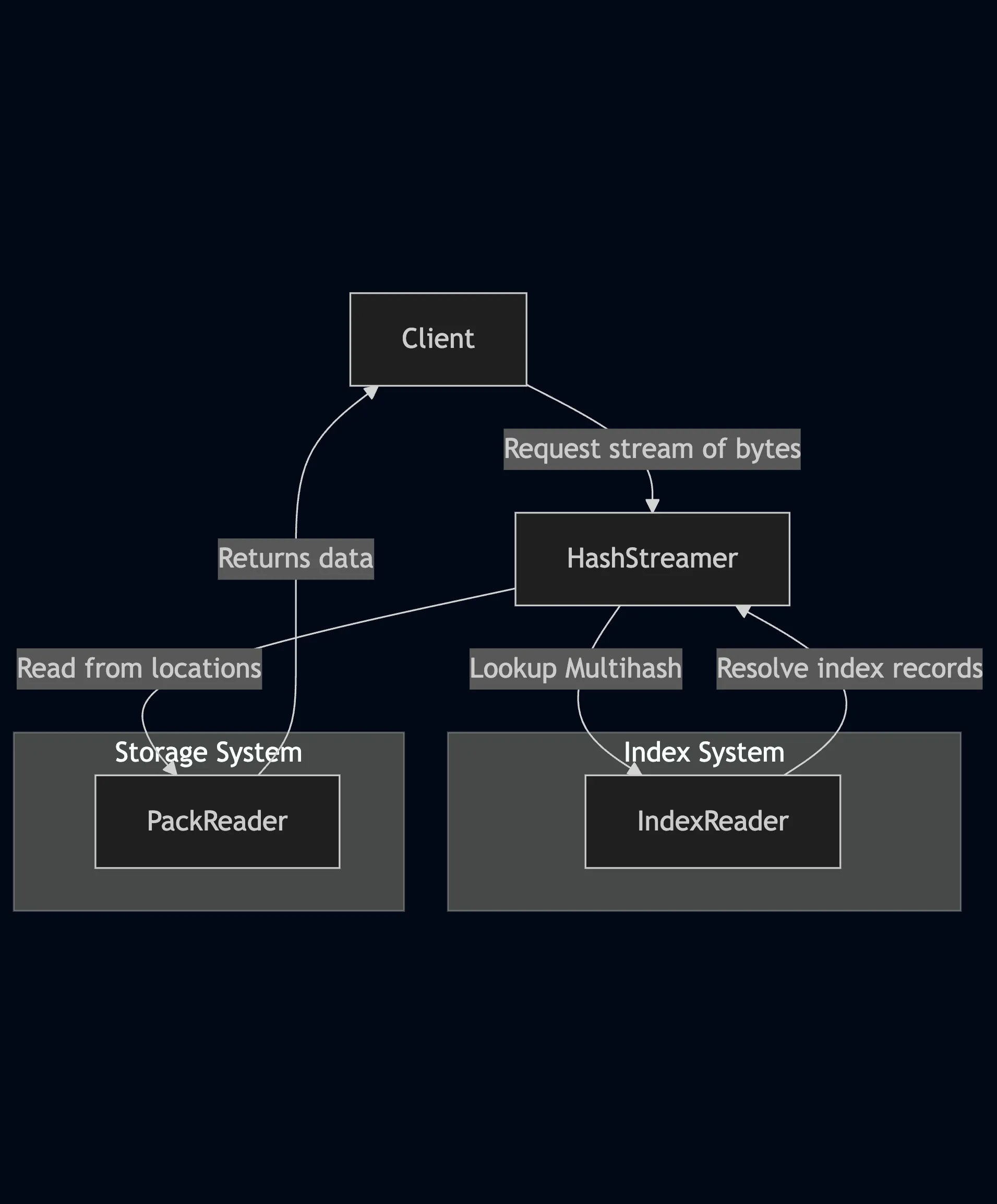Index
Editors
Section titled “Editors”Authors
Section titled “Authors”Abstract
Section titled “Abstract”This document describes an indexing protocol that enables content-addressable data to be served efficiently by a server with access to stored verifiable packs and indexes.
Language
Section titled “Language”The key words “MUST”, “MUST NOT”, “REQUIRED”, “SHALL”, “SHALL NOT”, “SHOULD”, “SHOULD NOT”, “RECOMMENDED”, “MAY”, and “OPTIONAL” in this document are to be interpreted as described in RFC2119.
Overview
Section titled “Overview”Smart client implementations MAY request a verifiable pack as a single verifiable blob (e.g. RAW) or as a verifiable pack of blobs (e.g., CAR]). The server relies on indexes that enable it to handle requests efficiently. This specification cover the index primitives to enable verifiable content retrievability.
Fundamentals
Section titled “Fundamentals”There are three different fundamental lenses, which the indexing system MAY be able to index and enable queries for:
- A Blob is a set of bytes that is individually addressed by a multihash. It can be stored as is in a given store, or within a Pack.
- A Pack holds several Blobs and is also individually addressed by a multihash (can be seen as a Blob itself). Multiple Packs MAY store the same Blob.
- A Containing represents a set of Blobs/Packs. It can be individually addressed by a multihash and implies some cryptographic relationship.
Design Principles
Section titled “Design Principles”The design of the indexing system considers the following key aspects:
Modular & Pluggable Indexing:
Section titled “Modular & Pluggable Indexing:”- The protocol supports multiple indexing strategies based on different trade-offs.
- Implementations can choose the best index type depending on cost, performance, and use case.
- Supports integrating new indexing mechanisms without requiring changes to the core protocol.
Storage Efficiency & Cost Optimization:
Section titled “Storage Efficiency & Cost Optimization:”- The protocol aims to minimize storage and retrieval costs by leveraging compact and structured index formats.
System Design
Section titled “System Design”The indexer system can be decoupled into a set of key components:
Index Record
Section titled “Index Record”An index record has the necessary metadata to find the location where the bytes behind a given MultihashDigest rest. It can be represented as follows:
import { MultihashDigest } from 'multiformats'
type IndexRecord = { // MultihashDigest identifiying the record multihash: MultihashDigest // Type of the record type: IndexRecordType // hash digest of the location or Path location: MultihashDigest | Path // length of the data length?: number // offset of the data in the location byte stream offset?: number // associated records subRecords: Array<IndexRecord>}
// Record Type Enumtype IndexRecordType = BLOB | PACK | CONTAINING | INLINE_BLOBtype BLOB = 0type PACK = 1type CONTAINING = 2type INLINE_BLOB = 3
type Path = stringIt is worth pointing out that when an index record is of type INLINE_BLOB, the location is the hash digest of the raw Blob as identity multihash.
Index Store Reader
Section titled “Index Store Reader”Index records can be read from a given store based on the following Reader interface.
import { MultihashDigest } from 'multiformats'
interface IndexStoreReader { get(hash: MultihashDigest): AsyncIterable<IndexRecord>}Index Reader Interface
Section titled “Index Reader Interface”The index reader MUST support finding locations where given multihashes are stored.
import { MultihashDigest } from 'multiformats'
interface IndexReader { // Stores indexed entries store: IndexStore
// Find the index records related to the requested multihash findRecords( multihash: MultihashDigest, // similar to https://github.com/ipfs/specs/pull/462 options?: { containingMultihash?: MultihashDigest } ): AsyncIterable<IndexRecord>}Relationship Between Components
Section titled “Relationship Between Components”Reading Previously Indexed Data
- A client requests a stream of bytes behind a given multihash using a Hash Streamer.
- The Hash Streamer queries the appropriate Index.
- The Index Reader provides index records representing the location where requested multihash bytes are stored.
- The Hash Streamer fetches the actual data based on the resolved locations (see
hash-streamer.md).

